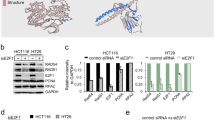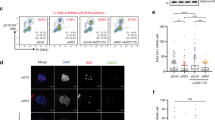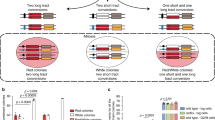Abstract
Genetic instability caused by mutations in the p53 gene is generally thought to be due to a loss of the DNA damage response that controls checkpoint functions and apoptosis. Cells with mutant p53 exhibit high levels of homologous recombination (HR). This could be an indirect consequence of the loss of DNA damage response or p53 could have a direct role in HR. Here, we report that p53−/− mouse embryonic fibroblasts (MEFs) exhibit higher levels of the RAD51 protein and increased level of spontaneous RAD51 foci Agents that stall replication forks, for example, hydroxyurea (HU), potently induce HR repair and RAD51 foci. To test if the increase in RAD51 foci in p53−/− MEFs was due to an increased level of damage during replication, we measured the formation of DNA double-strand breaks (DSBs) in p53+/+ and p53−/− MEFs following treatments with HU. We found that HU induced DSBs only in p53−/− MEFs, indicating that p53 is involved in a pathway to protect stalled replication forks from being collapsed into a substrate for HR. Also, p53 is upregulated in response to agents that inhibit DNA replication, which supports our hypothesis. Finally, we observed that the DSBs produced in p53−/− MEFs did not result in a permanent arrest of replication and that they were repaired. Altogether, we suggest that the effect of p53 on HR and RAD51 levels and foci can be explained by the idea that p53 suppresses formation of recombinogenic lesions.
This is a preview of subscription content, access via your institution
Access options
Subscribe to this journal
Receive 50 print issues and online access
$259.00 per year
only $5.18 per issue
Buy this article
- Purchase on Springer Link
- Instant access to full article PDF
Prices may be subject to local taxes which are calculated during checkout






Similar content being viewed by others
Abbreviations
- CPT:
-
camptothecin
- DSBs:
-
DNA double-strand breaks
- HR:
-
homologous recombination
- HU:
-
hydroxyurea
- MEFs:
-
mouse embryonic fibroblasts
- TdR:
-
thymidine
- VP16:
-
etoposide
References
Arnaudeau C, Lundin C and Helleday T . (2001). J. Mol. Biol., 307, 1235–1245.
Bertrand P, Rouillard D, Boulet A, Levalois C, Soussi T and Lopez BS . (1997). Oncogene, 14, 1117–1122.
Bianchi V, Pontis E and Reichard P . (1986). J. Biol. Chem., 261, 16037–16042.
Bjursell G and Reichard P . (1973). J. Biol. Chem., 248, 3904–3909.
Buchhop S, Gibson MK, Wang XW, Wagner P, Sturzbecher HW and Harris CC . (1997). Nucleic Acids Res., 25, 3868–3874.
Chehab NH, Malikzay A, Appel M and Halazonetis TD . (2000). Genes Dev., 14, 278–288.
Chen G, Yuan SS, Liu W, Xu Y, Trujillo K, Song B, Cong F, Goff SP, Wu Y, Arlinghaus R, Baltimore D, Gasser PJ, Park MS, Sung P and Lee EY . (1999). J. Biol. Chem., 274, 12748–12752.
Cox MM . (2001). Annu. Rev. Genet., 35, 53–82.
Cranston A, Bocker T, Reitmair A, Palazzo J, Wilson T, Mak T and Fishel R . (1997). Nat. Genet., 17, 114–118.
Flygare J, Armstrong RC, Wennborg A, Orsan S and Hellgren D . (1998). FEBS Lett., 427, 247–251.
Gottifredi V, Shieh S, Taya Y and Prives C . (2001). Proc. Natl. Acad. Sci. USA, 98, 1036–1041.
Haaf T, Golub EI, Reddy G, Radding CM and Ward DC . (1995). Proc. Natl. Acad. Sci. USA, 92, 2298–2302.
Hirao A, Kong YY, Matsuoka S, Wakeham A, Ruland J, Yoshida H, Liu D, Elledge SJ and Mak TW . (2000). Science, 287, 1824–1827.
Huang Y, Nakada S, Ishiko T, Utsugisawa T, Datta R, Kharbanda S, Yoshida K, Talanian RV, Weichselbaum R, Kufe D and Yuan ZM . (1999). Mol. Cell. Biol., 19, 2986–2997.
Janz C and Wiesmuller L . (2002). Oncogene, 21, 5929–5933.
Janz C, Susse S and Wiesmuller L . (2002). Oncogene, 21, 2130–2140.
Karow JK, Constantinou A, Li JL, West SC and Hickson ID . (2000). Proc. Natl. Acad. Sci. USA, 97, 6504–6508.
Kovalenko OV, Plug AW, Haaf T, Gonda DK, Ashley T, Ward DC, Radding CM and Golub EI . (1996). Proc. Natl. Acad. Sci. USA, 93, 2958–2963.
Lee S, Cavallo L and Griffith J . (1997). J. Biol. Chem., 272, 7532–7539.
Lim DS and Hasty P . (1996). Mol. Cell. Biol., 16, 7133–7143.
Lundin C, Erixon K, Arnaudeau C, Schultz N, Jenssen D, Meuth M and Helleday T . (2002). Mol. Cell. Biol., 22, 5869–5878.
Lundin C, Schultz N, Arnaudeau C, Mohindra A, Hansen LT and Helleday T . (2003). J. Mol. Biol., 328, 521–535.
Mekeel KL, Tang W, Kachnic LA, Luo CM, DeFrank JS and Powell SN . (1997). Oncogene, 14, 1847–1857.
Raderschall E, Bazarov A, Cao J, Lurz R, Smith A, Mann W, Ropers HH, Sedivy JM, Golub EI, Fritz E and Haaf T . (2002). J. Cell. Sci., 115, 153–164.
Saintigny Y and Lopez BS . (2002). Oncogene, 21, 488–492.
Saintigny Y, Rouillard D, Chaput B, Soussi T and Lopez BS . (1999). Oncogene, 18, 3553–3563.
Schultz N, Lopez E, Saleh-Gohari N and Helleday T . (2003). Nucleic Acids Res., 31, 4959–4964.
Schwartz D and Rotter V . (1998). Semin. Cancer Biol., 8, 325–336.
Sengupta S, Linke SP, Pedeux R, Yang Q, Farnsworth J, Garfield SH, Valerie K, Shay JW, Ellis NA, Wasylyk B and Harris CC . (2003). EMBO J., 22, 1210–1222.
Shen Z, Pardington-Purtymun PE, Comeaux JC, Moyzis RK and Chen DJ . (1996a). Genomics, 37, 183–186.
Shen Z, Pardington-Purtymun PE, Comeaux JC, Moyzis RK and Chen DJ . (1996b). Genomics, 36, 271–279.
Shieh SY, Ahn J, Tamai K, Taya Y and Prives C . (2000). Genes Dev., 14, 289–300.
Shu Z, Smith S, Wang L, Rice MC and Kmiec EB . (1999). Mol. Cell. Biol., 19, 8686–8693.
Sogo JM, Lopes M and Foiani M . (2002). Science, 297, 599–602.
Sonoda E, Sasaki MS, Buerstedde JM, Bezzubova O, Shinohara A, Ogawa H, Takata M, Yamaguchi-Iwai Y and Takeda S . (1998). EMBO J., 17, 598–608.
Strumberg D, Pilon AA, Smith M, Hickey R, Malkas L and Pommier Y . (2000). Mol. Cell. Biol., 20, 3977–3987.
Sturzbecher HW, Donzelmann B, Henning W, Knippschild U and Buchhop S . (1996). EMBO J., 15, 1992–2002.
Subramanian D and Griffith JD . (2002). Nucleic Acids Res., 30, 2427–2434.
Susse S, Janz C, Janus F, Deppert W and Wiesmuller L . (2000). Oncogene, 19, 4500–4512.
Taylor WR, Agarwal ML, Agarwal A, Stacey DW and Stark GR . (1999). Oncogene, 18, 283–295.
Willers H, McCarthy EE, Alberti W, Dahm-Daphi J and Powell SN . (2000). Int. J. Radiat. Biol., 76, 1055–1062.
Xia SJ, Shammas MA and Shmookler Reis RJ . (1997). Mol. Cell. Biol., 17, 7151–7158.
Yang Q, Zhang R, Wang XW, Spillare EA, Linke SP, Subramanian D, Griffith JD, Li JL, Hickson ID, Shen JC, Loeb LA, Mazur SJ, Appella E, Brosh Jr RM, Karmakar P, Bohr VA and Harris CC . (2002). J. Biol. Chem., 277, 31980–31987.
Yuan ZM, Huang Y, Ishiko T, Nakada S, Utsugisawa T, Kharbanda S, Wang R, Sung P, Shinohara A, Weichselbaum R and Kufe D . (1998). J. Biol. Chem., 273, 3799–3802.
Zhang H, Richards B, Wilson T, Lloyd M, Cranston A, Thorburn A, Fishel R and Meuth M . (1999). Cancer Res., 59, 3021–3027.
Zou H and Rothstein R . (1997). Cell, 90, 87–96.
Acknowledgements
We thank Miss Elena Lopez for technical assistance, Drs Mark Meuth, Helen Bryant and Kayan Parker for critically reading this manuscript and Dr Agneta Önfelt for the use of microscopy. This investigation was supported by the Swedish Cancer Society, the Swedish National Board for Laboratory Animals, Biological & Biotechnological Sciences Research Council and Yorkshire Cancer Research.
Author information
Authors and Affiliations
Corresponding author
Rights and permissions
About this article
Cite this article
Kumari, A., Schultz, N. & Helleday, T. p53 protects from replication-associated DNA double-strand breaks in mammalian cells. Oncogene 23, 2324–2329 (2004). https://doi.org/10.1038/sj.onc.1207379
Received:
Revised:
Accepted:
Published:
Issue Date:
DOI: https://doi.org/10.1038/sj.onc.1207379
Keywords
This article is cited by
-
Transferrin facilitates the formation of DNA double-strand breaks via transferrin receptor 1: the possible involvement of transferrin in carcinogenesis of high-grade serous ovarian cancer
Oncogene (2016)
-
Chromosome instability and deregulated proliferation: an unavoidable duo
Cellular and Molecular Life Sciences (2012)
-
The G1 phase Cdks regulate the centrosome cycle and mediate oncogene-dependent centrosome amplification
Cell Division (2011)
-
A reduction of licensed origins reveals strain-specific replication dynamics in mice
Mammalian Genome (2011)
-
p53 in recombination and repair
Cell Death & Differentiation (2006)



